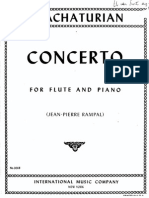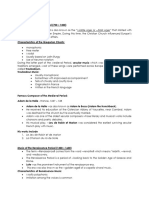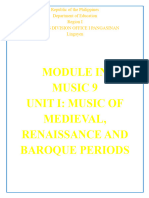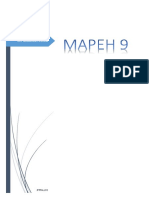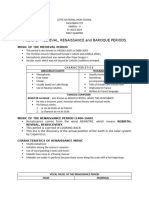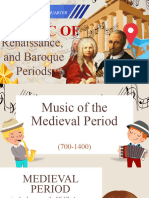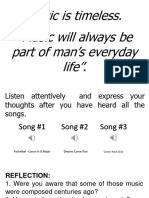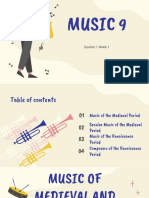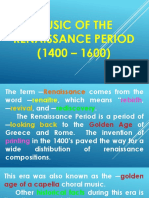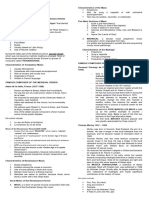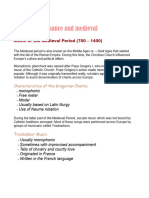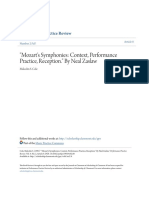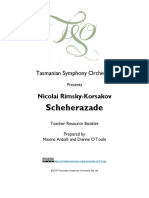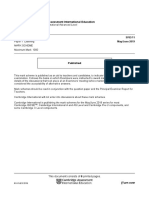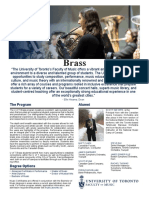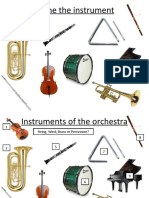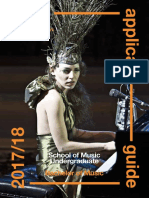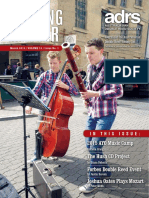0 ratings0% found this document useful (0 votes)
124 viewsUNIT 1: Music of Medieval, Renaissance, and Baroque Periods
UNIT 1: Music of Medieval, Renaissance, and Baroque Periods
Uploaded by
Millette Mesa ArañasThe document summarizes key aspects of vocal music from the Medieval, Renaissance, and Baroque periods. It describes the monophonic Gregorian chants of the Medieval period and the emergence of polyphonic masses and madrigals in the Renaissance. Major composers highlighted include Palestrina, Morley, Bach, Vivaldi, and Handel. The Baroque period saw more elaborate melodies and dynamic contrast, with new genres like concerto, concerto grosso, and chorale developing.
Copyright:
© All Rights Reserved
Available Formats
Download as DOCX, PDF, TXT or read online from Scribd
UNIT 1: Music of Medieval, Renaissance, and Baroque Periods
UNIT 1: Music of Medieval, Renaissance, and Baroque Periods
Uploaded by
Millette Mesa Arañas0 ratings0% found this document useful (0 votes)
124 views2 pagesThe document summarizes key aspects of vocal music from the Medieval, Renaissance, and Baroque periods. It describes the monophonic Gregorian chants of the Medieval period and the emergence of polyphonic masses and madrigals in the Renaissance. Major composers highlighted include Palestrina, Morley, Bach, Vivaldi, and Handel. The Baroque period saw more elaborate melodies and dynamic contrast, with new genres like concerto, concerto grosso, and chorale developing.
Original Description:
GRADE 9 LECTURE
Original Title
1st Grading in MUSIC
Copyright
© © All Rights Reserved
Available Formats
DOCX, PDF, TXT or read online from Scribd
Share this document
Did you find this document useful?
Is this content inappropriate?
The document summarizes key aspects of vocal music from the Medieval, Renaissance, and Baroque periods. It describes the monophonic Gregorian chants of the Medieval period and the emergence of polyphonic masses and madrigals in the Renaissance. Major composers highlighted include Palestrina, Morley, Bach, Vivaldi, and Handel. The Baroque period saw more elaborate melodies and dynamic contrast, with new genres like concerto, concerto grosso, and chorale developing.
Copyright:
© All Rights Reserved
Available Formats
Download as DOCX, PDF, TXT or read online from Scribd
Download as docx, pdf, or txt
0 ratings0% found this document useful (0 votes)
124 views2 pagesUNIT 1: Music of Medieval, Renaissance, and Baroque Periods
UNIT 1: Music of Medieval, Renaissance, and Baroque Periods
Uploaded by
Millette Mesa ArañasThe document summarizes key aspects of vocal music from the Medieval, Renaissance, and Baroque periods. It describes the monophonic Gregorian chants of the Medieval period and the emergence of polyphonic masses and madrigals in the Renaissance. Major composers highlighted include Palestrina, Morley, Bach, Vivaldi, and Handel. The Baroque period saw more elaborate melodies and dynamic contrast, with new genres like concerto, concerto grosso, and chorale developing.
Copyright:
© All Rights Reserved
Available Formats
Download as DOCX, PDF, TXT or read online from Scribd
Download as docx, pdf, or txt
You are on page 1of 2
UNIT 1: Music of Medieval, VOCAL MUSIC OF THE RENAISAANCE PERIOD
Renaissance, and Baroque Periods 1. Mass is a form of sacred musical
composition that sets texts of the
Music of the Medieval Period (700- Eucharistic liturgy into music.
1400) Characteristics of the Mass:
The Medieval period is also known as the Polyphonic
Middle Ages or Dark Ages that started with the May be sung a capella or with orchestral
fall of the Roman Empire. accompaniment
Text may be syllabic (one note set to each
MONOPHONIC PLAINCHANT was named after syllable), neumatic (a few notes set to one
Pope Gregory I, who made this the approved syllable), or melismatic (many notes to
music of the Catholic Church. one syllable)
CHARACTERISTICS OF THE GREGORIAN CHANTS: Five Main Sections of Mass:
Monophonic
Free meter Kyrie (Lord Have Mercy)
Modal Gloria (Glory to God in the Highest)
Usually based on Latin liturgy Credo (I Believe in One God
Use of Neume notation Sanctus and Benedictus (Holy, holy and
Blessed Is He)
TROUBADOUR MUSIC Agnus Dei (Lamb of God)
Usually monophonic
Sometimes with improvised 2. Madrigal A secular vocal polyphonic
accompaniment music composition which originated from
Tells of chivalry and courtly love Italy. It is written and expressed in a poetic
Originated in France text and sung during courtly social
Written in the French language gatherings. It is the most important
secular form during the Renaissance
FAMOUS COMPOSER OF THE MEDIEVAL PERIOD period.
Adam de la Halle, France (1237-1288) was
CHARACTERISTICS OF THE MADRIGAL:
also known as Adam le Bosu (Adam the
Hunchback). Adam was destined for the
Polyphonic
church but he eventually married. He was
Sung a capella
one of the oldest secular composers. He
Through composed
was a French-born-trouvere, poet and
musician. His musical play, Jeu de Robin et Frequently 3 to 6 voices
Marion was considered the earliest *Listen to April is In My Mistress Face
surviving secular French play with music. by Thomas Morley
La Chanson du roi de Sicile was also hos
Famous Composers of the Renaissance Period
work.
1. Giovanni Pierluigi da Palestrina, Rome,
Music of the Renaissance Period (1400-
1525 February 2, 1594 the greatest
1600)
master of Roman Catholic Church music
The term Renaissance comes from the
during the Renaissance period. Majority of
word renaitre which means rebirth, revival,
his composition are sacred music. He was
and rediscovery. The Renaissance Period is a
committed to sacred music and has a keen
period of looking back to the Golden Age of
interest in satisfying the desires of church
Greece and Rome.
leaders in the sixteenth century.
Lute the prominent instrument of the
2. Thomas Morley, 1557 - 1602 - he was the
renaissance era.
most famous composer of secular music in
Though sacred music was still of great
his time. He received his bachelors degree
importance, secular music became more
in Oxford and became an organist at St.
prominent in the renaissance period. This era was
Pauls in London.
also known as the golden age of a capella choral
His Musica Transalpina, a
music.
collection of Italian madrigals fitted with
CHARACTERISTICS OF RENAISSANCE MUSIC:
English text, was published in 1588 by
Mostly polyphonic
Nicholas Yonge. He began publishing his
Imitation among the voices is common own collections of madrigals and made
Use of word painting in text and music significant contribution to the history of
Melodic lines move in a flowing manner music.
Melodies are easier to perform because
these move along a scale with a few large His works include:
leaps
Fire, Fire, My Heart
Sing and Chant It
Fantasie
April Is In My Mistress Face 5. Chorale - musical compositions that
It Was A Lover and His Lass resemble a harmonized version of hymnal
tunes of the Protestant Church during the
Music of the Baroque Period (1685- Baroque era.
1750)
FAMOUS COMPOSERS OF THE BAROQUE
The word Baroque is derived from the PERIOD
Portugese word barroco which means pearl of
irregular shape. Some of the great composers of 1. Johann Sebastian Bach, Germany, March
this time were George Friedrich Handel, Johann 21, 1685 July 28, 1750 He came from a
Sebastian Bach, Claudio Monteverdi, and Antonio family of musicians. Bachs beautiful
Vivaldi. soprano singing voice helped him to be
accepted at a school in Luiiberg. A few
CHARACTERISTICS OF BAROQUE MUSIC: years later, his voice changed and Bach
focused his attention to playing the violin
Melodies sound elaborate and ornamental and harpsichord.
Melodies are not easy to sing or His works include:
remember Concerto Grosso (Brandenburg Concertos)
Primarily contrapuntal textures with some Masses (Mass in B minor)
homophony Cantatas (Cantata 208 and 211)
Dynamic contrast alteration between Fugues (Fugue in G minor)
loud and soft Works for clavichord and harpsichord
Music genres operas, oratorios, suites,
tocatas, concerto grosso, fugue 2. Antonio Vivaldi, Venice, March 4, 1678
Orchestra consists of strings and continuo July 28, 1741 in Vienna he is also named
Harpsichord and organ are the keyboard il Prete Rosso (The Red Priest) because
instruments that are commonly used of his red hair, he was an Italian Baroque
New forms: composer, Catholic priest and a virtuoso
1. Binary AD violinist. His most famous piece is The
2. Ternary ABC Four Seasons. This composition is a series
3. Ground bass of four violin concerti depicting each of
4. Fugue the seasons, Spring, Summer, Autumn,
and Winter.
MUSIC GENRES OF BAROQUE MUSIC
3. George Friedrich Handel, Germany,
1. Concerto a form of orchestral music that February 23, 1685 April 14, 1759 in
employs a solo instrument accompanied London he was the second son from the
by an orchestra. second marriage of a pastor. Despite his
2. Concerto Grosso a form of orchestral fathers opposition, George secretly
music during the Baroque Period wherein taught himself to play the harpsichord.
the music is between a small group of solo Handel is remembered for his operas and
instruments called concertino and the oratorios.
whole orchestra called tutti. Handel lost both of his eyesight in
3. Fugue 1753. When he conducted his oratorio,
A contrapuntal piece, developed Samson, a few in the audience were
mainly by imitative counterpoint unaware that he had lost his eyesight.
It is usually written 3 or 4 parts, The Messiah is Handels most
with a main theme called famous creation and the very well-known
subject Hallelujah chorus is part of handels
The entire piece grows mainly Messiah.
from a single brief tune of strong The Messiah was written in the
musical character apace of twenty four days in London but
4. Oratorio a large scale musical it was in Dublin when The Messiah was
composition for orchestra and voices that first performed and became an instant
incorporates narratives on religious success.
themes. Unlike usual theatrical works, this
is usually performed without the use of
costumes, scenery, or action.
Examples:
a. Handels Messiah, Samson, Israel,
and Egypt
b. Bachs Christmas Oratorio
c. Haydns The Creation
You might also like
- Khachaturian Flute Concerto PDFDocument65 pagesKhachaturian Flute Concerto PDFgretapoc100% (1)
- Playing For Time Actor S Script AddendumDocument13 pagesPlaying For Time Actor S Script AddendumKyrademNo ratings yet
- Music of Medieval, Renaissance, and Baroque PeriodDocument36 pagesMusic of Medieval, Renaissance, and Baroque PeriodKenneth D. Manalili50% (2)
- CH07 IM Baroque InstrumentalDocument7 pagesCH07 IM Baroque InstrumentaljpisisNo ratings yet
- Powerpoint in Music Lsson IIDocument62 pagesPowerpoint in Music Lsson IIRodRigo Mantua Jr.No ratings yet
- Morton Feldman: List of Works: Date Title Instruments Publisher Recording CDDocument8 pagesMorton Feldman: List of Works: Date Title Instruments Publisher Recording CDVANNI MONTANARI100% (1)
- Mahler VoicesDocument376 pagesMahler Voiceskonst669100% (6)
- G-9 Muisc First Quarter SummaryDocument3 pagesG-9 Muisc First Quarter SummaryJosa Gracia PanganibanNo ratings yet
- Grade 9 Music Quarter 1 ReviewerDocument6 pagesGrade 9 Music Quarter 1 ReviewerLianne Ramos67% (3)
- 1 STDocument2 pages1 STSaligan DolfNo ratings yet
- Music 1ST Quarter LessonsDocument2 pagesMusic 1ST Quarter LessonsCathrine AntonesNo ratings yet
- 9 Q1 Reviewer MAPEHDocument12 pages9 Q1 Reviewer MAPEHMa Belle Jasmine DelfinNo ratings yet
- Music of The RenaissanceDocument10 pagesMusic of The RenaissanceTon DuNo ratings yet
- Music Lesson 1st Quarter Grade 9Document2 pagesMusic Lesson 1st Quarter Grade 9Elton Martin de Leon67% (6)
- First Grading Reviewer in Mapeh 9Document5 pagesFirst Grading Reviewer in Mapeh 9Archie ZapantaNo ratings yet
- Mapeh9 - Western Classical MusicDocument3 pagesMapeh9 - Western Classical MusicKheza Bohol Deliman DañasNo ratings yet
- Medieval Period (700-1400) : NeumesDocument4 pagesMedieval Period (700-1400) : NeumesMarites ParaguaNo ratings yet
- Module in Music 9Document19 pagesModule in Music 9Michelle CostalesNo ratings yet
- Mapeh 9Document19 pagesMapeh 9Hannah Menchie AbulonNo ratings yet
- Music Outline 1st QuarterDocument4 pagesMusic Outline 1st QuarterHotaru TakegawaNo ratings yet
- 1Q-MUSICDocument4 pages1Q-MUSICgia85223No ratings yet
- 1Q Music 9Document3 pages1Q Music 9Christel RamirezNo ratings yet
- Music of of Medieval, Renaissance and Baroque PeriodsDocument29 pagesMusic of of Medieval, Renaissance and Baroque PeriodsArlene Jane RamosNo ratings yet
- Q1 Music of Medieval Renaissance and Baroque PeriodDocument23 pagesQ1 Music of Medieval Renaissance and Baroque PeriodEden AlamerNo ratings yet
- Musicofthemedieval PeriodDocument30 pagesMusicofthemedieval PeriodHannah Faye Ambon- NavarroNo ratings yet
- Music of The Medieval PeriodDocument3 pagesMusic of The Medieval PeriodGRascia Ona100% (1)
- 1ST QTR MAPEH 9 HANDOUTDocument19 pages1ST QTR MAPEH 9 HANDOUTtrisha isayas100% (1)
- Music of Medieval, Renaissance, and Baroque PeriodDocument35 pagesMusic of Medieval, Renaissance, and Baroque Periodangelo.natividad18No ratings yet
- Papa Mapeh 9 ModuleDocument42 pagesPapa Mapeh 9 ModuleTroy Quinto De GuzmanNo ratings yet
- Musicofthemedievalrenaissancebaroquemusic 150420091709 Conversion Gate01Document24 pagesMusicofthemedievalrenaissancebaroquemusic 150420091709 Conversion Gate01Hannah Faye Ambon- NavarroNo ratings yet
- Handouts in Quarter 1 Music 9Document2 pagesHandouts in Quarter 1 Music 9cjleste5No ratings yet
- Music 9 ReviewerDocument2 pagesMusic 9 ReviewerkeishaerojoNo ratings yet
- Reading Materials Music Q1Document3 pagesReading Materials Music Q1obiasayannahNo ratings yet
- Music of Medieval, Renaissance and Baroque PeriodsDocument31 pagesMusic of Medieval, Renaissance and Baroque PeriodsDouglasCurtis100% (1)
- Mapeh 9Document85 pagesMapeh 9quenee lablab100% (2)
- MUSIC 9 Q1 Copy 1Document33 pagesMUSIC 9 Q1 Copy 1Illa LagumbayNo ratings yet
- Music-Q1 GR 9Document57 pagesMusic-Q1 GR 9aritha.olivanNo ratings yet
- Music of Medieval, Renaissance and Baroque PeriodDocument3 pagesMusic of Medieval, Renaissance and Baroque PeriodMarricon Perez Abadiez LagumbayNo ratings yet
- Mapeh 9 WK 2Document31 pagesMapeh 9 WK 2DENISE MAREE ROMASANTANo ratings yet
- Q1-Music - 9-MODULE-NEW EDITEDDocument11 pagesQ1-Music - 9-MODULE-NEW EDITEDRonnel GuevarraNo ratings yet
- Music of The Medieval Period (700 - 1400)Document33 pagesMusic of The Medieval Period (700 - 1400)Ning Ning Mananghaya EstradaNo ratings yet
- Learner's Activity Sheet: MAPEH Music (Quarter I - Week 1)Document12 pagesLearner's Activity Sheet: MAPEH Music (Quarter I - Week 1)She Ena Man UelNo ratings yet
- 1st MusicDocument63 pages1st Musicmatzukazetenma09No ratings yet
- Music of The Medieval PeriodDocument33 pagesMusic of The Medieval PeriodEric Jordan ManuevoNo ratings yet
- Music ReviewerDocument5 pagesMusic ReviewerIra AdvinculaNo ratings yet
- Music 9 Lesson '1Document55 pagesMusic 9 Lesson '1Arthur LaurelNo ratings yet
- Western MusicDocument46 pagesWestern Musicelisiavote01No ratings yet
- MAPEH-reviewerDocument26 pagesMAPEH-reviewerWilliam Ìce AsisNo ratings yet
- Music of The Medieval PeriodDocument33 pagesMusic of The Medieval PeriodEric Jordan ManuevoNo ratings yet
- Eras of MusicDocument50 pagesEras of MusicShiela PlanasNo ratings yet
- Finance Review PDFDocument4 pagesFinance Review PDFguevarrasakura09No ratings yet
- Music Lesson 2Document36 pagesMusic Lesson 2Hydeelyn BringasNo ratings yet
- Western Traditional Music9 - 1stQDocument42 pagesWestern Traditional Music9 - 1stQclifford.dmnhsNo ratings yet
- Music Grade 9 Quarter 1 NotesDocument9 pagesMusic Grade 9 Quarter 1 NotesreinnaflorpepitoniangaNo ratings yet
- Music 9 1ST QuarterDocument40 pagesMusic 9 1ST QuarterAMERONA LALACNo ratings yet
- Music of The Renaissance Period (1400 - 1600)Document24 pagesMusic of The Renaissance Period (1400 - 1600)RodRigo Mantua Jr.No ratings yet
- Music of The Medieval Period (700-1400) (Autosaved)Document51 pagesMusic of The Medieval Period (700-1400) (Autosaved)Naomi Roshan100% (2)
- Vocal and Instrumental Music ofDocument23 pagesVocal and Instrumental Music ofsheryl ann dionicioNo ratings yet
- Las Mapeh 9 Music Week 1Document4 pagesLas Mapeh 9 Music Week 1Joseph Eric NardoNo ratings yet
- Music 9 1 Quarter MUSIC OF THE MEDIEVAL (700-1400), RENAISSANCE (1400-1600), AND BAROQUE (1685-1750) PERIODSDocument7 pagesMusic 9 1 Quarter MUSIC OF THE MEDIEVAL (700-1400), RENAISSANCE (1400-1600), AND BAROQUE (1685-1750) PERIODSKaren Jamito Madridejos100% (1)
- MAPEH 1stquater Reviewer-OutlineDocument7 pagesMAPEH 1stquater Reviewer-Outlinereysheilannej.calalo10No ratings yet
- Music of The Medieval Period (700-1400)Document6 pagesMusic of The Medieval Period (700-1400)Reijel AgubNo ratings yet
- MemorareDocument53 pagesMemorareGhia Cressida HernandezNo ratings yet
- MusicDocument5 pagesMusicRomirose DelrioNo ratings yet
- A Treasury of Early Music: Masterworks of the Middle Ages, the Renaissance and the Baroque EraFrom EverandA Treasury of Early Music: Masterworks of the Middle Ages, the Renaissance and the Baroque EraRating: 3.5 out of 5 stars3.5/5 (4)
- Mozarts Symphonies - Context Performance Practice Reception.Document8 pagesMozarts Symphonies - Context Performance Practice Reception.Adrian KranjcevicNo ratings yet
- Scheherazade: Nicolai Rimsky-KorsakovDocument18 pagesScheherazade: Nicolai Rimsky-KorsakovCleiton XavierNo ratings yet
- Music of Haydn, Beethoven & Schubert: He Art of The Early Keyboard Series in PrincetonDocument9 pagesMusic of Haydn, Beethoven & Schubert: He Art of The Early Keyboard Series in PrincetonG TothNo ratings yet
- STEPHEN FISSEL, Bass Trombone: MEADE CRANE, PianoDocument5 pagesSTEPHEN FISSEL, Bass Trombone: MEADE CRANE, PianoErik MardonesNo ratings yet
- 1st Arts and Music (Third Module) MINIMIZEDDocument13 pages1st Arts and Music (Third Module) MINIMIZEDDennmark IgutNo ratings yet
- Cambridge Assessment International Education: Music 9703/11 May/June 2019Document6 pagesCambridge Assessment International Education: Music 9703/11 May/June 2019Papageorgiou VasoNo ratings yet
- The American Wind BandDocument41 pagesThe American Wind BandlopesdougllasNo ratings yet
- Group 3 - History of Instrumental MusicDocument33 pagesGroup 3 - History of Instrumental MusicjentitularNo ratings yet
- U of T Brass SnapshotDocument2 pagesU of T Brass SnapshotDejan KneževićNo ratings yet
- MAPEH 6 - MUSIC PPT Q3 - Musical Instruments 1Document31 pagesMAPEH 6 - MUSIC PPT Q3 - Musical Instruments 1John Rex RugaNo ratings yet
- Geoffrey Gordon: Concerto For Trombone and Orchestra - Review: International Trombone Association Journal.Document2 pagesGeoffrey Gordon: Concerto For Trombone and Orchestra - Review: International Trombone Association Journal.Geoffrey GordonNo ratings yet
- Music, Performance, and The Realities of Film Shared Concert Experiences in Screen FictionDocument277 pagesMusic, Performance, and The Realities of Film Shared Concert Experiences in Screen Fiction李轻舟No ratings yet
- Role Conductor Schuller PDFDocument5 pagesRole Conductor Schuller PDFSaxoFloxNo ratings yet
- Ntse Test Series: Stage-1 Qualified StudentsDocument37 pagesNtse Test Series: Stage-1 Qualified StudentsQSQFNo ratings yet
- McCreary RocketeerAnalysisDocument20 pagesMcCreary RocketeerAnalysisPepe100% (1)
- Chamber & Solo Music of Krzysztof PendereckiDocument8 pagesChamber & Solo Music of Krzysztof PendereckiEzioNo ratings yet
- MUSIC9 Q3 Module 3Document21 pagesMUSIC9 Q3 Module 3edel dearce IIINo ratings yet
- 4th Quarter ExamDocument7 pages4th Quarter ExamMarston Glenn F. TugahanNo ratings yet
- Introduction To The Classical Period in Music: Rococo, Galant, or Simply Pre-ClassicalDocument44 pagesIntroduction To The Classical Period in Music: Rococo, Galant, or Simply Pre-ClassicalThomas JosephNo ratings yet
- The Young Person's Guide To The OrchestraDocument40 pagesThe Young Person's Guide To The OrchestrajuandagvNo ratings yet
- NYO 2020 Timpani Excerpts UpdatedDocument6 pagesNYO 2020 Timpani Excerpts UpdatedKayqui AssisNo ratings yet
- Andrew Seidel - ResumeDocument2 pagesAndrew Seidel - Resumeapi-283067085No ratings yet
- Music Quiz NEWDocument15 pagesMusic Quiz NEWLouiseNo ratings yet
- Guide For Applicants BMus PDFDocument17 pagesGuide For Applicants BMus PDFMarina AlexopoulouNo ratings yet
- ReedingMatter March 2015 E-VersionDocument32 pagesReedingMatter March 2015 E-VersionFrancesco Davide SalZanoNo ratings yet
